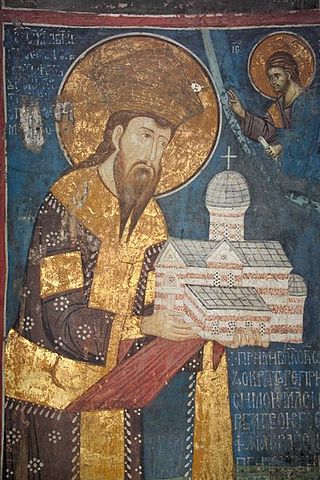Top Qs
Timeline
Chat
Perspective
Ktetor
Church benefactor or church warden in Orthodox Christianity From Wikipedia, the free encyclopedia
Remove ads
Ktetor (Greek: κτήτωρ) or ktitor (Cyrillic: ктитор; Georgian: ქტიტორი kt’it’ori; Romanian: ctitor), meaning 'founder', is a title given in the Middle Ages in the Byzantine sphere to the provider of funds for construction or reconstruction of an Eastern Orthodox church or monastery, for the addition of icons, frescos, and other works of art. The Catholic equivalent of the term is donator. At the time of founding, the ktetor often issued typika, and was illustrated on frescoes ("ktetor portrait"). The female form is ktetorissa (Greek: κτητόρισσα) or ktitoritsa (Cyrillic: ктиторица).

The donator or renovator of churches are known as "second ktetor" or "new ktetor" (Serbian: Други ктитор, нови ктитор).
Remove ads
History
Summarize
Perspective
You can help expand this article with text translated from the corresponding article in Serbian. (August 2025) Click [show] for important translation instructions.
|
The Serbian Nemanjić dynasty were ktetors to many monasteries and churches, including the "Medieval Monuments in Kosovo" inscribed as World Heritage.
Remove ads
Notable people
- Saint Sava, Serbian Archbishop (1219–35), founded Hilandar and reconstructed Karakallou, Xeropotamou, and Philotheou at Mount Athos.[1]
- Andronikos II Palaiologos, Byzantine emperor (r. 1282–1328), founded the monasteries of Ardenica and reconstructed the destroyed Zograf.
- Stefan Dušan, Serbian king and emperor (r. 1331–55), founded the monasteries of the Holy Archangels, Podlastva, Duljevo and reconstructed Visoki Dečani.
Remove ads
Sources
- Mileusnić, Slobodan (2000) [1989]. Sveti Srbi (in Serbian). Novi Sad: Prometej. ISBN 8676394784. OCLC 44601641.
- Thomas, John P. (1987). Private Religious Foundations in the Byzantine Empire. Washington, D.C.: Dumbarton Oaks. ISBN 9780884021643.
- Geoffrey Wainwright (2006). The Oxford History of Christian Worship. Oxford University Press, USA. pp. 287–. ISBN 978-0-19-513886-3.
Further reading
Wikiwand - on
Seamless Wikipedia browsing. On steroids.
Remove ads
